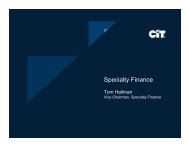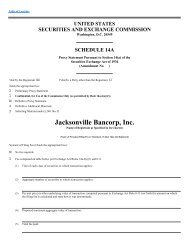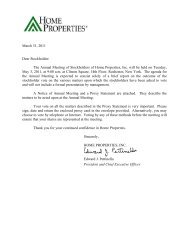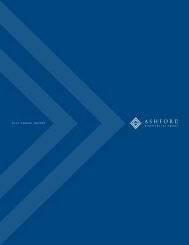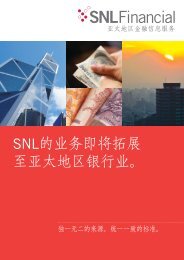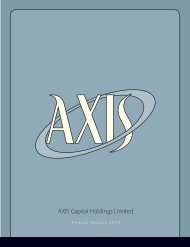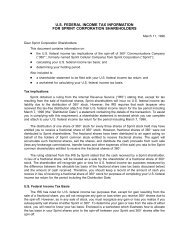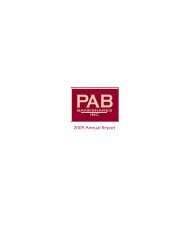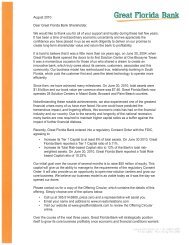Cousins Properties Incorporated 2006 Annual Report - SNL Financial
Cousins Properties Incorporated 2006 Annual Report - SNL Financial
Cousins Properties Incorporated 2006 Annual Report - SNL Financial
You also want an ePaper? Increase the reach of your titles
YUMPU automatically turns print PDFs into web optimized ePapers that Google loves.
Income Taxes<br />
COUSINS PROPERTIES INCORPORATED AND SUBSIDIARIES<br />
NOTES TO CONSOLIDATED FINANCIAL STATEMENTS — (Continued)<br />
<strong>Cousins</strong> has elected to be taxed as a REIT under the Internal Revenue Code of 1986, as amended (the “Code”).<br />
To qualify as a REIT, <strong>Cousins</strong> must distribute annually at least 90% of its adjusted taxable income, as defined in the<br />
Code, to its stockholders and satisfy certain other organizational and operating requirements. It is management’s<br />
current intention to adhere to these requirements and maintain <strong>Cousins</strong>’ REIT status. As a REIT, <strong>Cousins</strong> generally<br />
will not be subject to federal income tax at the corporate level on the taxable income it distributes to its shareholders.<br />
If <strong>Cousins</strong> fails to qualify as a REIT in any taxable year, it will be subject to federal income taxes at regular corporate<br />
rates (including any applicable alternative minimum tax) and may not be able to qualify as a REIT for four<br />
subsequent taxable years. <strong>Cousins</strong> may be subject to certain state and local taxes on its income and property, and to<br />
federal income taxes on its undistributed taxable income.<br />
CREC uses the liability method of accounting for income taxes. Deferred income tax assets and liabilities<br />
result from temporary differences. Temporary differences are differences between the tax bases of assets and<br />
liabilities and their reported amounts in the financial statements that will result in taxable or deductible amounts in<br />
future periods.<br />
In June <strong>2006</strong>, the FASB issued FASB Interpretation No. 48, “Accounting for Income Tax Uncertainties”<br />
(“FIN 48”). FIN 48 defines the threshold for recognizing tax return positions in the financial statements as those<br />
which are “more-likely-than-not” to be sustained upon examination by the taxing authority. FIN 48 also provides<br />
guidance on derecognition, measurement and classification of income tax uncertainties, along with any related<br />
interest and penalties, accounting for income tax uncertainties in interim periods and the level of disclosures<br />
associated with any recorded income tax uncertainties. FIN 48 is effective January 1, 2007 for the Company. The<br />
Company does not anticipate the effect of adopting the provisions of FIN 48 will be material to its financial position<br />
or results of operations.<br />
Stock-Based Compensation<br />
The Company has several types of stock-based compensation plans which are described in Note 7. In<br />
December 2004, the FASB issued SFAS No. 123 (revised 2004) (“SFAS 123R”), “Share-Based Payment.” This<br />
standard requires the recognition of compensation expense for the grant-date fair value of all share-based awards<br />
granted after the date the standard is adopted, and for the fair value of the unvested portion of awards issued prior to<br />
the date the standard is adopted. The Company adopted SFAS 123R using the modified prospective method of<br />
adoption in the fiscal quarter beginning January 1, <strong>2006</strong>. Additional disclosures related to stock-based compensation<br />
are included in Note 7. For periods prior to <strong>2006</strong>, the Company accounted for its stock-based compensation<br />
under APB No. 25, “Accounting for Stock Issued to Employees,” and related interpretations as permitted by<br />
SFAS No. 123, “Accounting for Stock-Based Compensation.” APB No. 25 required the recording of compensation<br />
expense for some stock-based compensation, including restricted stock, but did not require companies to record<br />
compensation expense on stock options where the exercise price was equal to the market value of the underlying<br />
stock on the date of grant. Accordingly, the Company did not record compensation expense for stock options in the<br />
Consolidated Statements of Income prior to January 1, <strong>2006</strong>, as all stock options granted have an exercise price<br />
equal to the market value of the underlying common stock on the date of grant. Compensation expense for stockbased<br />
compensation previously expensed under APB No. 25 did not materially change under SFAS 123R.<br />
The Company uses the Black-Scholes model to value its new stock option grants under SFAS 123R.<br />
SFAS 123R also requires the Company to estimate forfeitures in calculating the expense related to stock-based<br />
compensation. In addition, SFAS 123R requires the Company to reflect the benefits of tax deductions in excess of<br />
recognized compensation cost to be reported as both a financing cash inflow and an operating cash outflow upon<br />
adoption. The effect on operating and financing cash flows was approximately $2.6 million in <strong>2006</strong> related to these<br />
tax benefits. The Company adopted the transition method described in FSP FAS 123R-3, “Transition Election<br />
Related to Accounting for the Tax Effect of Share-Based Payment Awards.”<br />
F-11




